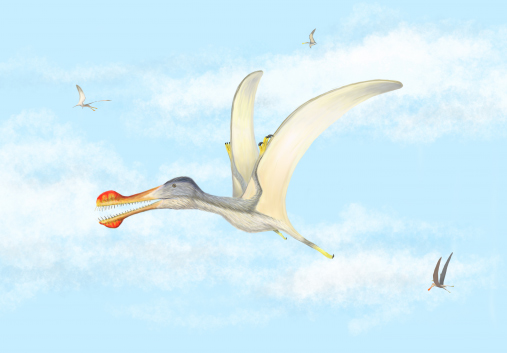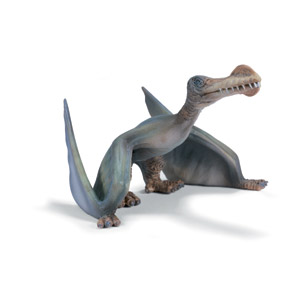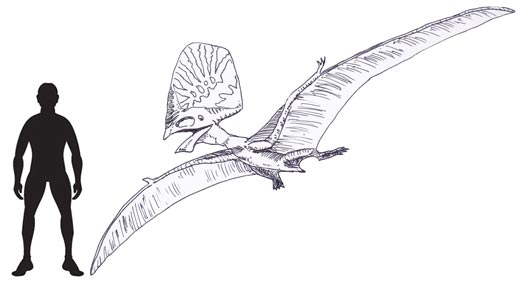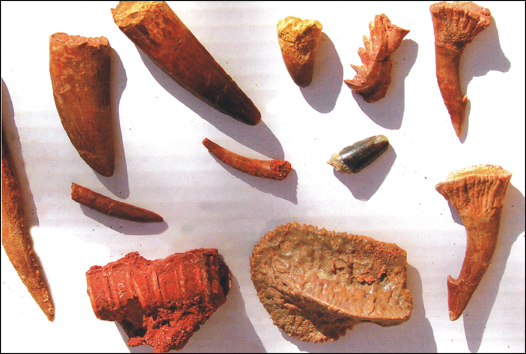The “Golden Age” of Pterosauria Research
In the last few weeks, a number of scientific papers have been published detailing new pterosaur discoveries and fossil finds. We really do seem to be living in a “golden age” of flying reptile research. For example, researchers have identified the fragmentary fossil remains of three types of pterosaur from the famous Cretaceous Kem Kem beds of Morocco (Anhanguera, Coloborhynchus and Ornithocheirus). Even before the dust had settled on that publication, another scientific paper, published this week, describes Afrotapejara zouhrii, the newest member of the Tapejaridae, fossils of which also come from the enigmatic Kem Kem beds.
The “Golden Age” of Pterosaur Research – Illustration of Three of the New Pterosaur Types Described

Picture credit: Megan Jacobs (Baylor University, Texas)
Cretaceous Fossils Mixed Up in a Blender
The Kem Kem Formation is exposed in south-eastern Morocco and neighbouring Algeria. The extensive deposits represent an inter-tidal, estuarine environment with large, wide lagoons and a broad floodplain criss-crossed by numerous rivers. These sediments were laid down in the Albian to Cenomanian faunal stages of the Cretaceous, approximately 100 to 95 million years ago.
The terrestrial landscape was dominated by dinosaurs, surprisingly, there seems to have been an overabundance of big theropods present – Spinosaurus, Rugops (other abelisaurs), Sauroniops, Deltadromeus, Carcharodontosaurus, potential dromaeosaurids and a wealth of other fossil bones and isolated teeth that represent indeterminate species.
Trouble is, the transport of material due to river and tidal action has resulted in a mixing up of fossil material. Fossil beds contain a vast array of jumbled up, disarticulated material, much of which may also have been re-deposited from its original stratigraphic layer. These deposits have been colourfully described as representing fossils that have been put in a blender, such is their mixing and depositional status.
Typical Isolated and Fragmentary Vertebrate Fossil Remains from the Kem Kem Beds
Pterosaurs as Piscivores
In the first scientific paper, researchers from the University of Portsmouth, Baylor University (Waco, Texas), the University of Detroit Mercy (Detroit), Leicester University, the Laboratoire Santé et Environnement (Morocco) and the University of Bath report on the discovery of fragmentary jaws and associated teeth that led to the identification of three new types of pterosaur.
The remains suggest three ornithocheirid pterosaurs, a second species of Coloborhynchus and an Ornithocheirus reminiscent of Ornithocheirus fossil material known from the Cambridge Greensand deposits of southern England. In addition, a portion of a lower jaw (mandibular symphysis), closely resembles that of the South American ornithocheirid Anhanguera piscator, fossils of which are known from the roughly contemporaneous Romualdo Member of the Santana Formation (Brazil).
An Illustration of Anhanguera (Ornithocheiridae Family)

Fossils from Morocco
As well as representing a turbulent depositional environment, the fossiliferous beds of south-eastern Morocco provide an additional challenge for scientists. Local residents mine the sedimentary rocks, often using only rudimentary tools and materials, so that they can sell their fossil finds to dealers and collectors. Fortunately, in this case, the fragments of jaw were acquired by scientists enabling a proper academic investigation to be carried out. The teeth of these pterosaurs suggest that they were probably piscivores, the largest of which probably had a wingspan in excess of four metres.
In the paper, the researchers conclude that the Kem Kem fossil assemblage includes at least nine species of pterosaur, of which the majority (five), are members of the Ornithocheiridae. These strata help to support the theory that toothed pterosaurs remained diverse throughout the late Early Cretaceous, before going into decline and eventually disappearing after the Cenomanian faunal stage.
And There’s More – Another Moroccan Pterosaur This Time a Tapejarid
New pterosaur discoveries are behaving a bit like buses at the moment (prior to the coronavirus pandemic), three come along and then shortly afterwards another one turns up. Many of the same scientists from the first academic paper, have published, albeit a little earlier than expected, another paper, this time naming a new species tapejarid pterosaur. Unlike the other three, this flying reptile was edentulous (no teeth in the jaws). The newly described tapejarid has been named Afrotapejara zouhrii, based on yet more fragmentary material including jaw elements.
A Typical Illustration of a Tapejarid Pterosaur

Picture credit: Everything Dinosaur
Fossils of Pterosaurs from the Kem Kem Beds
Fossil jaws seem to be taphonomically selected for in the Kem Kem beds. Other pterosaur remains have been frequently reported from these deposits, but rarely are the fossils diagnostic. Isolated mandibular material had hinted at the present of tapejarids in northern Africa in the Early Cretaceous, but Afrotapejara is the first genus to be erected. It represents the fourth example of a toothless pterosaur taxon to have been described from the Kem Kem beds and it provides the first unambiguous evidence to support the presence of the Tapejaridae in Africa. The genus name translates as “African tapejarid”, whilst we suspect that the specific name honours Samir Zouhri, one of the authors of the first pterosaur paper reported upon in this blog post.
Based on this evidence, it seems that we really are living in a “golden age” of pterosaur research.
The first scientific paper: “New toothed pterosaurs (Pterosauria: Ornithocheiridae) from the middle Cretaceous Kem Kem beds of Morocco and implications for pterosaur palaeobiogeography and diversity” by Megan L. Jacobs, David M. Martill, David M. Unwin, Nizar Ibrahim, Samir Zouhri and Nicholas R. Longrich published in Cretaceous Research.
The second scientific paper: “A new tapejarid (Pterosauria, Azhdarchoidea) from the mid-Cretaceous Kem Kem beds of Takmout, southern Morocco” by David M. Martill, Roy Smith, David M. Unwin, Alexander Kao, James McPhee and Nizar Ibrahim published in Cretaceous Research.
The Everything Dinosaur website: Everything Dinosaur.







Leave A Comment